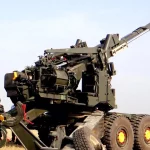India’s 5th-generation fighter jet ambitions are gathering momentum as Defence Secretary Rajesh Kumar Singh confirmed that the development contract for the Advanced Medium Combat Aircraft (AMCA) program will be awarded within the next three to six months. Speaking to CNBC-TV18, Singh said the program had reached a “critical juncture” in its path to bolster India’s airpower amid growing security concerns in the Indo-Pacific.
The AMCA is a twin-engine, 25-tonne stealth multirole fighter jet being developed by the Aeronautical Development Agency (ADA) under DRDO. Envisioned as a cornerstone of India’s aerial combat capability by 2035, the jet is intended for both the Indian Air Force and Navy. The program was approved by the Cabinet Committee on Security (CCS) in March 2024 with an initial budget of ₹15,000 crore for prototype development.
Breaking from traditional models, the AMCA is being developed under a Public-Private Partnership (PPP) structure approved by Defence Minister Rajnath Singh in May 2025. Major private defence players like Tata and Larsen & Toubro (L&T) are now eligible to independently or jointly bid for the contract alongside HAL, marking a new chapter in indigenous defence manufacturing.
The Defence Ministry issued an Expression of Interest (EOI) on June 18, 2025, inviting Indian industry participation in prototype development, flight testing, and certification. Interested firms must respond by August 16, 2025. The selected private partner will be required to establish dedicated facilities and deliver five prototypes, with rollout expected by 2028 and the first flight scheduled for late 2028 or early 2029.
The AMCA Mk1 variant will be powered by the GE F414 engine (98 kN thrust), while the Mk2 will incorporate a more powerful 110 kN indigenous engine being developed by DRDO’s Gas Turbine Research Establishment (GTRE), in collaboration with a foreign partner — likely Safran of France.
Designed for missions ranging from air superiority and ground attack to Suppression of Enemy Air Defences (SEAD) and electronic warfare, the AMCA will feature cutting-edge stealth technology, an internal weapons bay (1,500 kg payload), external payload capacity of 5,500 kg, and 6,500 kg of internal fuel.
DRDO Chief Dr. Samir V. Kamat stated that the aircraft’s development trials will conclude by 2034, paving the way for full-scale production by 2035. The project is expected to significantly enhance India’s defence self-reliance and complement recent achievements such as the Tejas Mk1A’s operational success in Operation Sindoor.
With co-production talks for the F414 engine nearing completion and the contract award expected between October 2025 and January 2026, the AMCA program is set to usher India into the league of nations fielding indigenous 5th-generation stealth fighters.













